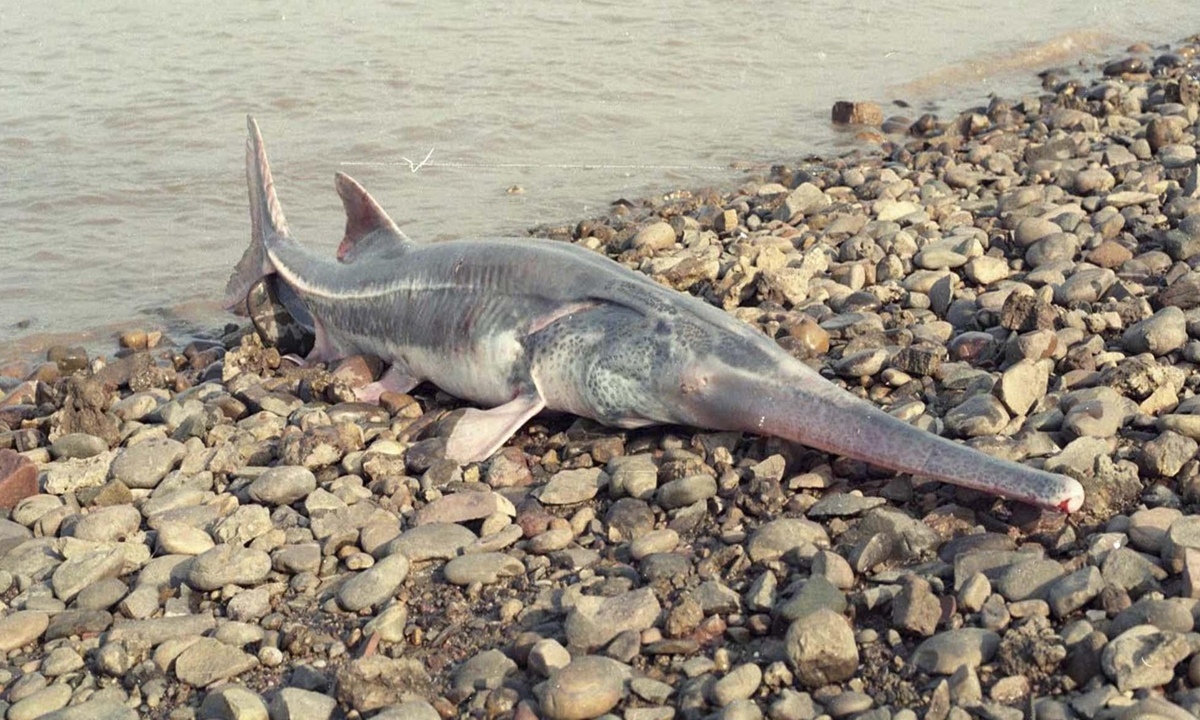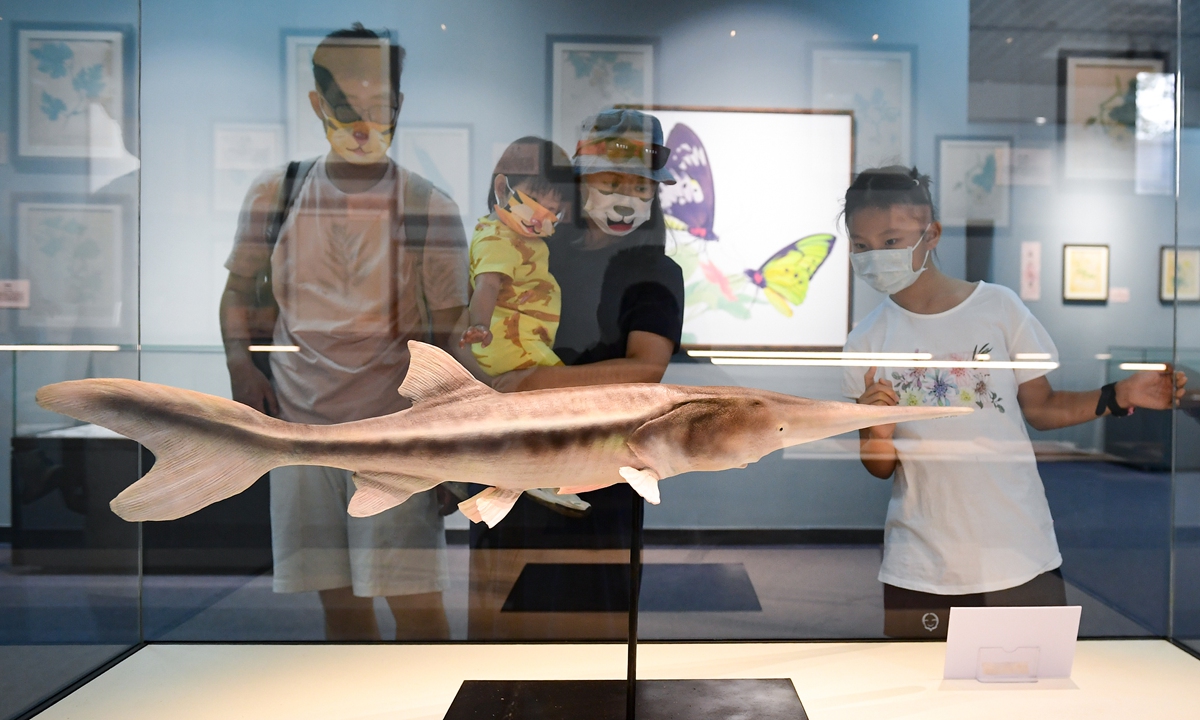IN-DEPTH / IN-DEPTH
Extinction of Chinese paddlefish raises awareness on biodiversity protection in China’s largest river
Saving big fishes

A Chinese paddlefish found in Yichang, Central China's Hubei Province in 1993. Photo: Courtesy of Wei Qiwei
It might be many people's first time hearing about the "Chinese paddlefish (Psephurus gladius)," and they probably have never witnessed them swimming in the Yangtze River with their own eyes.The species, which has been living and evolving on the planet for more than 150 million years along with dinosaurs, pandas and humans, was, in the end, declared extinct by the International Union for Conservation of Nature (IUCN) on July 21, 2022.
Nineteen years after it was last spotted, the giant fish, which could grow to a length of a whopping 7 meters, disappeared from the world, leaving no surviving domesticated individuals, only a few photo records and several specimens in formalin.
"We did not get opportunities to know their exact life span," Wei Qiwei, research professor at the Yangtze River Fisheries Research Institute, Chinese Academy of Fishery Sciences, told the Global Times.
Wei is the only Chinese member of the Sturgeon Specialist Group, Species Survival Commission IUCN. For decades, Wei and his team had been tracking the big fish along the Yangtze River and calling for the awareness of biodiversity.
The extinction of the Chinese paddlefish reminds people that more efforts must be made to protect the other sturgeon species, Wei said.
In recent years, China has stepped up efforts to protect aquatic animals in the Yangtze River basin, and the ecosystem is expected to gradually recover. Lessons learned from losing the Chinese paddlefish are a rallying cry in motivating people to protect the river.
Nowhere to be found
In 2003, Wei and his team rescued a Chinese Paddlefish accidentally caught by local fishermen in Yibin, Southwest China's Sichuan Province. The big fish was released back into the water after receiving treatment at the hands of Wei.
It turned out to be humans' last time sighting this species.
In the following decade, people have looked for traces of the Chinese paddlefish, but the fish has been nowhere to be found, until 19 years later when it was declared officially extinct.
According to the IUCN's standard, a species is presumed "extinct" "when exhaustive surveys in known and/or expected habitat, at appropriate times (diurnal, seasonal, annual), throughout its historic range have failed to record an individual."
In December 2019, Wei published an article, stating that between 2005 and 2010, the Chinese paddlefish might have become extinct. Not only that, but the species may have become functionally extinct as early as in 1993.
"Because of the limited research data on Chinese paddlefish, there is even no record of the species' lifespan. According to our estimates, the lifespan of the Chinese paddlefish is about 30 to 40 years," Wei Qiwei told the Global Times. In a paper published in 2019, Wei and his colleagues believe that the last reproductive cycle of the Chinese paddlefish may have been around 1990, so the last hatched paddlefish was likely to have already reached the end of its life.
Human activities such as overfishing are the leading cause of Chinese paddlefish's extinction, Wei said. "We could have had time to conduct research on them and conserve them artificially, but we were not given the opportunity."
Wei believes that if it were present day, at least people would have been capable enough to conserve the fish in artificial pools. But back in mid-1980s, when researchers were able to find samples, they were unable to carry out artificial breeding of the species.
The Chinese paddlefish is a species endemic to the Yangtze River, and is considered a top carnivore in the Yangtze River ecosystem.
According to National Geographic's description, the Chinese paddlefish possessed a long sword-like rostrum, a snout-like structure packed with cells to detect electrical currents from prey such as crustaceans. "They hunted over long distances throughout the expansive reaches of the Yangtze River basin, even making their way into the East China Sea."
It is also one of the very few ancient fishes to survive the Cretaceous period 150 million years ago. "From an evolutionary point of view, the Chinese paddlefish's ancestors appeared earlier than other species of fish. Therefore, the protection of the Chinese paddlefish has more important significance," Wei told the Global Times.
Once upon a time, the Chinese paddlefish widely populated the entire Yangtze River. In the 1970s, fishermen in the Yangtze River could catch 25 tons of Chinese paddlefish annually. But such overfishing has caused a sharp decline in the species.
In 1988, it became a national first-class protected wild animal in China.

Visitors observe a specimen of the Chinese paddlefish at the Beijing Museum of Natural History on June 18, 2022. Photo: IC
With several specimens left, researchers including Wei Qiwei wish to bring back the Chinese paddlefish in the future through scientific and technological means."The Chinese paddlefish only has specimens and no living cells. We hope technology can help in the recovery of the populations in the future," Wei Qiwei said.
Racing against time
"100 percent of the world's remaining 26 sturgeon species are now at risk of extinction. Their decline is steeper than previously thought," the IUCN announced on Twitter.
Among them, the Yangtze sturgeon (Acipenser dabryanus), another of the flagship species of aquatic life in the Yangtze River, has had its status changed through conducted assessments from "critically endangered" to "extinct in the wild."
In addition to the Yangtze sturgeon, Wei said that the Chinese sturgeon (Acipenser sinensis) has also not been monitored for natural reproduction for five consecutive years, whose survival in the wild is worrying.
"But more fortunately than in the case of the Chinese paddlefish, the Yangtze sturgeon and Chinese sturgeon have been artificially conserved, but greater efforts are needed to achieve the recovery of natural populations," he said.
On July 24, the Three Gorges Corp Chinese Sturgeon Research Institute announced a breakthrough in artificially inducing female nucleus technology in the Yangtze sturgeon, which means the species has achieved parthenogenesis for the first time.
Over the past decades, the Three Gorges Corp has continuously promoted thematic research on the ecological impact of the dams on the Yangtze River, mastered the core technology of species protection such as the full artificial breeding of Chinese sturgeon, and successfully realized the large-scale breeding of 250,000 Chinese sturgeon fry.
In addition to technical breakthroughs in artificial breeding efforts, various fish research and conservation institutions in China have been dedicated to achieving large-scale stocking and release of rare fish species in the Yangtze River, which is also considered a major means of restoring wild populations and achieving natural rebounding of their populations.
On July 22, a total of more than 600,000 yuan ($88,860) worth of 220,000 artificial breeding Yangtze sturgeons and other rare fish species were released from Guangyang Island, Southwest China's Chongqing Municipality, into the Yangtze River.
Since 1984, China Three Gorges Corp (CTG) has carried out 65 consecutive releases of Chinese sturgeon, with a cumulative release of nearly 5.3 million tails.
Jiang Wei, chief engineer with the Chinese Sturgeon Research Institute of the CTG told the Global Times that after the full implementation of the 10-year fishing ban policy in the Yangtze River in 2020, population of various types of small fish species substantially rebounded, but the restoration of the ecosystem and the improvement of the biodiversity level still needed some time to recover.
"We are still in a race against time to take advantage of the 10-year fishing ban to mitigate the negative impact of declining wild resources on the reproduction of sturgeon populations in China," he said.
Defending the Yangtze River
"The Chinese paddlefish has gone, and we could not do anything to stop it. It is an environmental blemish left on history," said Wang Yamin, a professor at the Shandong University's School of Oceanography.
Wang noted that such problems have also occurred in other countries through development. "The American paddlefish (Polyodon spathula) in the Mississippi River, which is the only other species under the paddlefish family and looks almost exactly like the Chinese Paddlefish, faced a similar situation."
Wang noted that exploitation projects in the Yangtze River have been slowed down and even entirely halted, and various protection measures as well as increasing public awareness of biodiversity could allow a recovery of the ecosystem in the biggest river of China.
In recent years, China has been increasing its efforts to protect aquatic animals in the Yangtze River. The Ministry of Agriculture and Rural Affairs has issued a series of long-term action plans for the rescuing of Chinese Sturgeon species and the Yangtze finless porpoise (Neophocaena asiaeorientalis).
At the same times, in order to strengthen the protection and restoration of the ecological environment in the Yangtze River basin, facilitate the effective, and rational use of resources, safeguard ecological security, on January 1, 2021, a 10-year Yangtze fishing ban came into full effect, with some 231,000 fishermen surrendering nearly 111,000 boats.

Children learn about fishing ban in a summer vacation class in Yichang, Central China's Hubei Province, on August 6, 2021. Photo: IC
On March 1 the same year, the Yangtze River Protection Law came into effect, further promoting the implementation of the 10-year fishing ban policy at the legislative level.Experts and observers said that with the in-depth implementation of Yangtze River protection strategy, the fate of flagship species in the Yangtze River is expected to take a new turn.
"We will always remember the lessons learned from the extinction of the Chinese paddlefish, and will turn this regret into motivation to protect more fish in the Yangtze River," Mo Hongyuan, deputy chief of the Yichang Fishery Supervision Detachment, told the Global Times.
Mo noted that in recent years, Yichang has resolutely implemented fishing ban initiatives. Fisheries law enforcement authorities have secured 16 million yuan to plan for the deployment of more than 100 monitoring probes along the 232 kilometer Yangtze River Yichang section, while deploying a scientific research team to carry out big data storage of the navigation trajectory of vessels on the river, achieving multi-dimensional supervision over illegal fishing activities in water, land, and air.
"But what we see more is a change in people's attitudes. Many fishermen joined the anti-fishing patrols organized by the fisheries department after returning ashore from fishing," he said.
Mo pointed out that at present, the recovery of finless porpoise populations is one of the most significant indicators reflecting the improvement of the ecological environment in the Yangtze River.
Feeding on small fish and shrimp, porpoises had gradually disappeared following a sharp decline in fishery resources in the Yangtze River. Before 2015, the number of finless porpoises in the Yichang section of the Yangtze River was only two to three. But in 2018, data showed that there were about 1,012 Yangtze finless porpoises, Mo noted.
To create an aquatic environment suitable for fish breeding, hydropower stations along the Yangtze River have also taken action, having carried out a special "biological regulation" project for many years. The CTG, for example, has created artificial "flood peaks" by adjusting the scheduling of the Xiluodu-Xiangjiaba-Three Gorges Dams to meet the rising water conditions required for fish spawning in the Yangtze River, Jiang noted.



